2022.5.5 天气晴。
《graph self- supervised learning:a survey》
一、介绍
图上的深度学习多数关注于半监督学习/监督学习,但是对标签具有很严重的依赖性、泛化能力弱、鲁棒性弱,所以SSL(自监督学习)成为了一个promising的研究方向。
标签依赖性:标签的人工成本大,数据集大、领域知识多。
泛化能力弱:由于标签的存在很容易导致过拟合。
鲁棒性弱:对label-related的对抗攻击很脆弱。
在SSL中,模型通过一系列的手工辅助任务来进行学习(pretext tasks),这样监督信号就可以通过模型本身来获得,而不依赖于手工的标签,SSL这样使得模型可以获得informative representation。
SSL on CV、NLP与SSL on graph的gap(Fig. 1):
graph是不规则的非欧几里得结构。因此一些pretext的设计for网格结构数据不能够直接映射到图数据上来。更进一步的,图中的节点与拓扑结构紧密关联,但是在image和text中两者是分开的。因此如何处理这种关联也成为了设计pretext任务的challenge。
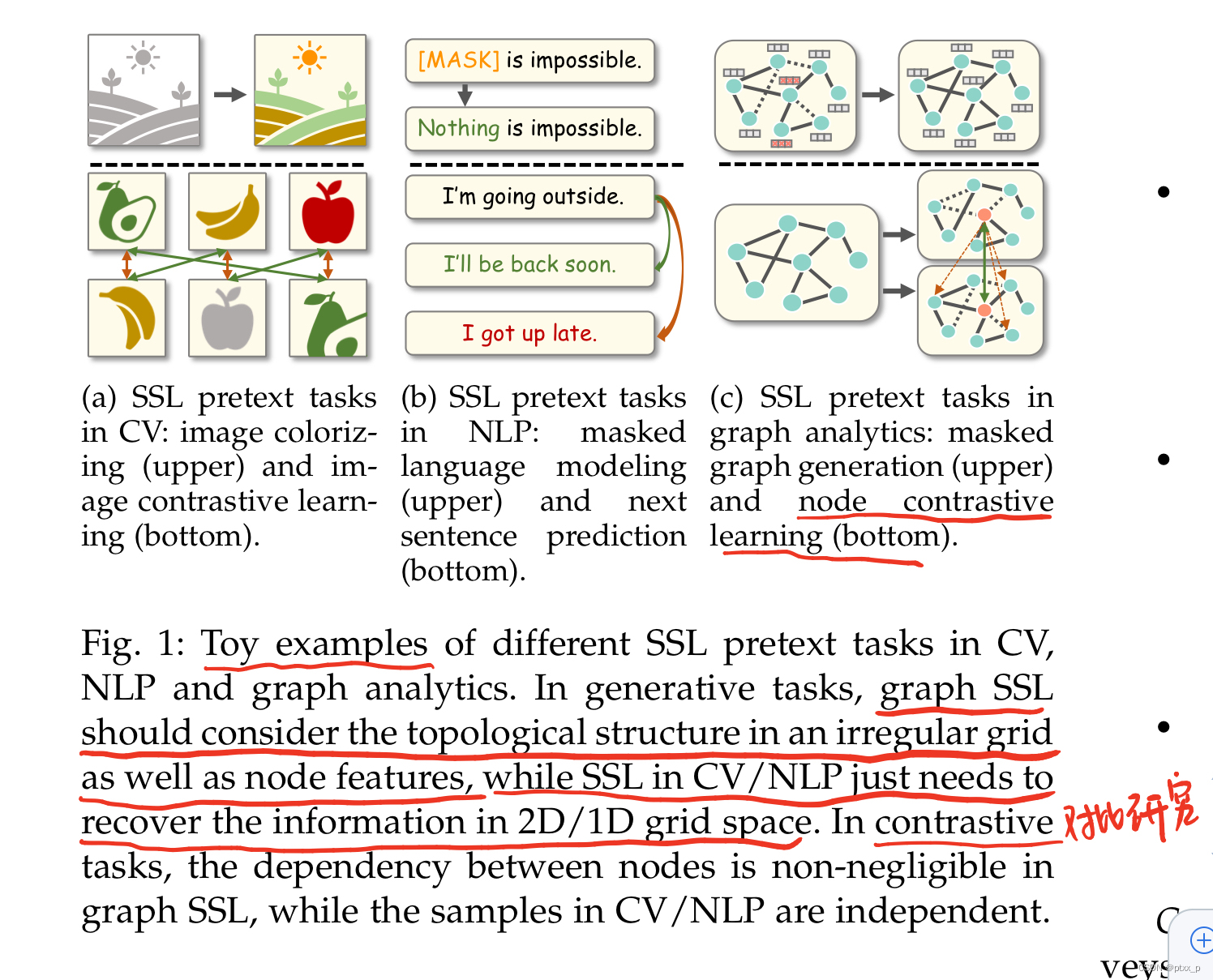
二、重要定义
手工标签vs伪标签:
手工标签:手工标注。
伪标签:算法自动根据数据生成,多在SSL中用来增强表示学习。
downstream tasks vs pretext tasks:
downstream tasks一般用来评测获得的graph embedding效果如何,如图分类和节点分类等。而pretext tasks则是用来帮助学习获得更好的representations,benifits downstream tasks。一般的,downstream tasks需要手工标签、pretext tasks需要伪标签。
自监督学习:
是无监督学习的一个subset,自监督学习指监督信息从data本身获取,模型通过pretext任务来获得更好的表现和泛化性能用于downstream tasks。
plain graph:
无属性、静态、同质图。G=(V,E)。
attributed graph:
节点或者是边具有属性。G=(V,E,X)。
很多GNN都使用了一个encoder的backbone,把节点特征变为节点表示(利用节点的联通关系等),readout函数常常用于根据节点表示来获得图级别的表示。
三、框架与分类
3.1 框架定义
encoder-decoder框架for graph SSL:
encoder
f
θ
f_{\theta}
fθ?用于学习low- dimensional representation(aka embedding):
h
i
∈
H
h_i \in H
hi?∈H。
pretext decoder p ? p_\phi p??:接收 H H H为输入for pretext tasks。 p θ p_{\theta} pθ?的结构依据具体的下游任务。
graph SSL可以被定义如下:
θ
?
,
?
?
=
argmin
?
θ
,
?
L
s
s
l
(
f
θ
,
p
?
,
D
)
.
(1)
\theta^*,\phi^* = \operatorname{argmin}_{\theta,\phi}\mathcal{L}_{ssl}(f_{\theta},p_{\phi},\mathcal{D}). \tag{1}
θ?,??=argminθ,??Lssl?(fθ?,p??,D).(1)
D
\mathcal{D}
D代表图数据分布,
L
s
s
l
\mathcal{L}_{ssl}
Lssl?代表SSL 损失函数。
通过使用学习到的graph encoder
f
θ
?
f_{\theta^*}
fθ??,生成的representation可以被用于各种的下游任务。定义一个下游任务decoder
q
ψ
q_{\psi}
qψ?,将下游任务视为一个图supervised learning task:
θ
?
?
,
ψ
?
=
argmin
?
θ
?
,
ψ
L
s
u
p
(
f
θ
?
,
q
ψ
,
G
,
y
)
.
(2)
\theta^{**},\psi^* = \operatorname{argmin}_{\theta^*,\psi}\mathcal{L}_{sup}(f_{\theta^*},q_{\psi},\mathcal{G},y).\tag{2}
θ??,ψ?=argminθ?,ψ?Lsup?(fθ??,qψ?,G,y).(2)
y
y
y:下游任务的标签,
L
s
u
p
\mathcal{L}_{sup}
Lsup?有监督损失函数用于下游任务。
3.2 图自监督学习的四种分类
通过使用不同的pretext decoders和objective functions,有四种分类:generation-based,auxiliary property-based,contrastive-based,hybrid methods.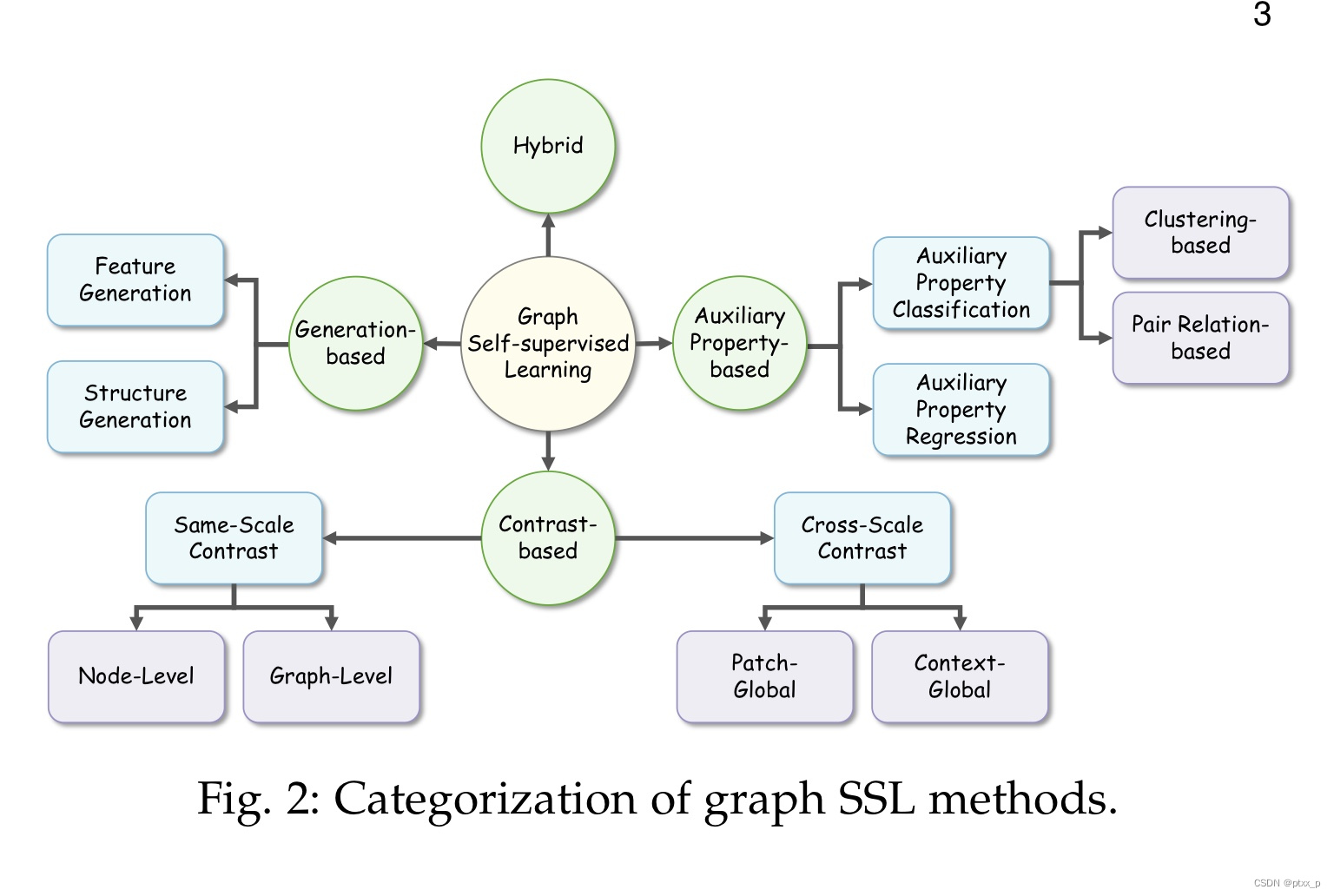
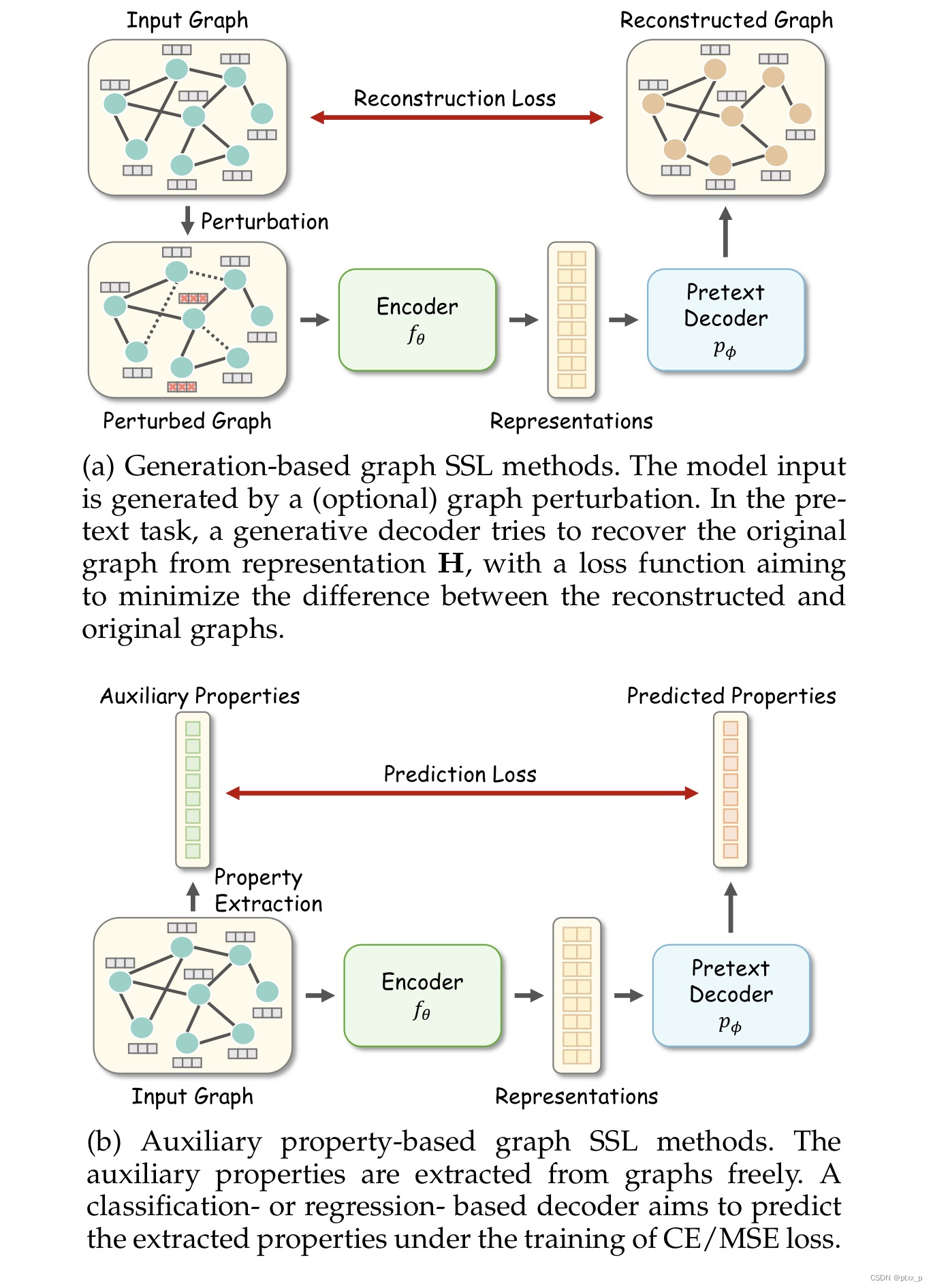
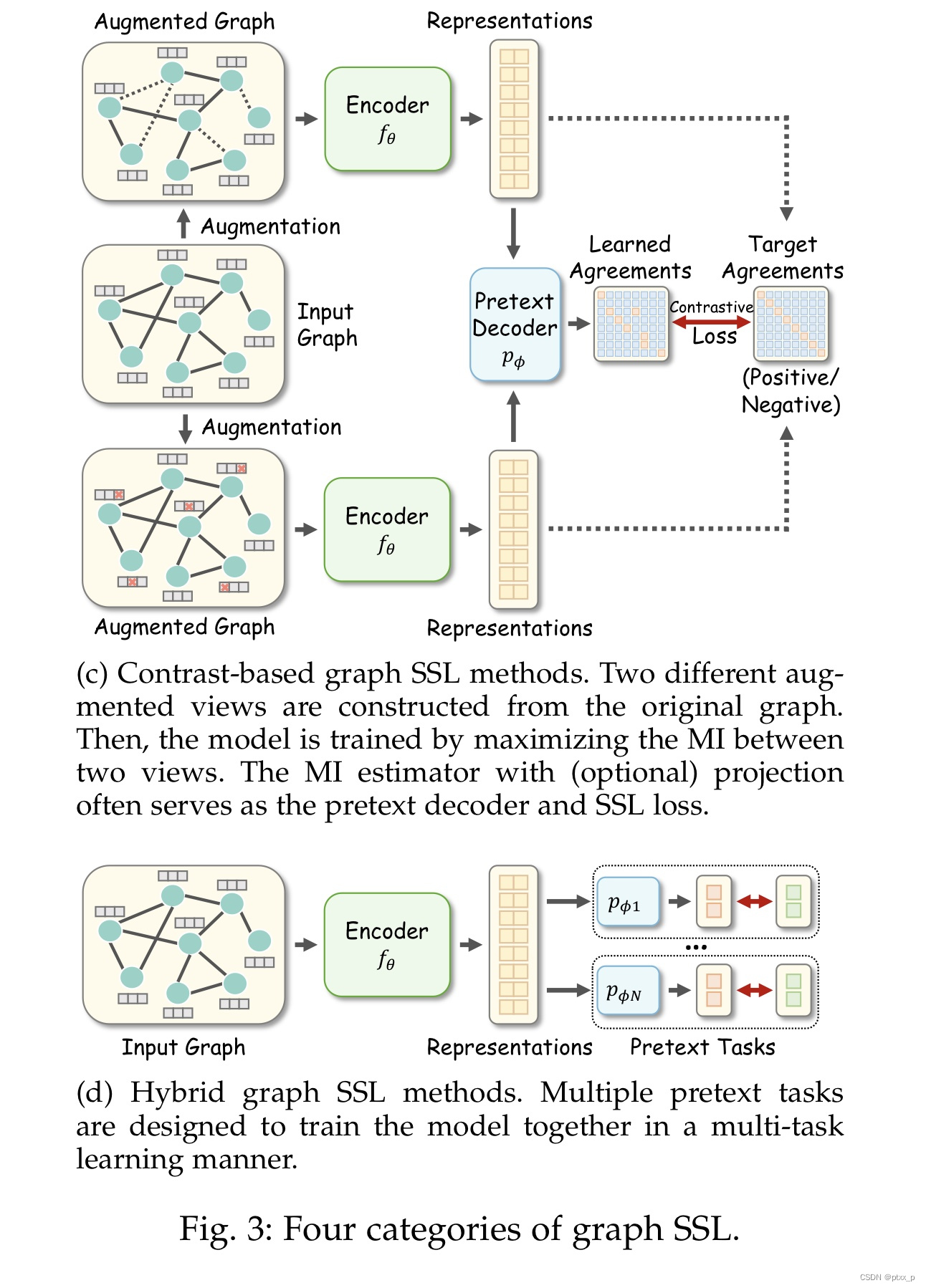
generation-based methods:
pretext task:图数据重构(图数据包括:node/edge特征和图的拓扑结构)。
可以重写公式(1)如下:
θ
?
,
?
?
=
argmin
?
θ
,
?
L
s
s
l
(
p
?
(
f
θ
(
G
~
)
)
,
G
)
.
\theta^*,\phi^* = \operatorname{argmin}_{\theta,\phi}\mathcal{L}_{ssl}(p_{\phi}(f_{\theta}(\tilde{\mathcal{G}})),\mathcal{G}).
θ?,??=argminθ,??Lssl?(p??(fθ?(G~?)),G).
此时 L s s l \mathcal{L}_{ssl} Lssl?一般用于测量重构图数据和原图数据的差距。
auxiliary property-based methods:
这种方法可以被进一步分类为:regression- and classification-based。
θ
?
,
?
?
=
argmin
?
θ
,
?
L
s
s
l
(
p
?
(
f
θ
(
G
)
)
,
c
)
.
\theta^*,\phi^* = \operatorname{argmin}_{\theta,\phi}\mathcal{L}_{ssl}(p_{\phi}(f_{\theta}({\mathcal{G}})),\mathcal{c}).
θ?,??=argminθ,??Lssl?(p??(fθ?(G)),c).
c
\mathcal{c}
c代表specific crafted auxiliary properties。对于regression-based方法,
c
\mathcal{c}
c可以是localized or global graph properties,如节点度或者到cluster的距离,此时
L
s
s
l
\mathcal{L}_{ssl}
Lssl?可以是MSE。对于classification-based方法,auxiliary properties可以是伪标签,如图切分或者cluster的下标,此时
L
s
s
l
\mathcal{L}_{ssl}
Lssl?可以是CE。
contrast-based methods:
基于互信息最大化的思想出发(mutual information maximization)。
θ
?
,
?
?
=
argmin
?
θ
,
?
L
s
s
l
(
p
?
(
f
θ
(
G
~
(
1
)
,
G
~
(
2
)
)
)
)
)
.
\theta^*,\phi^* = \operatorname{argmin}_{\theta,\phi}\mathcal{L}_{ssl}(p_{\phi}(f_{\theta}(\tilde{\mathcal{G}}^{(1)},\tilde{\mathcal{G}}^{(2)})))).
θ?,??=argminθ,??Lssl?(p??(fθ?(G~?(1),G~?(2))))).
其中
G
~
(
1
)
,
G
~
(
2
)
\tilde{\mathcal{G}}^{(1)},\tilde{\mathcal{G}}^{(2)}
G~?(1),G~?(2) 是不同的对图的增强视角。
pretext decoder
p
?
p_\phi
p??是一个discriminator(如bilinear function or dot product),
L
s
s
l
\mathcal{L}_{ssl}
Lssl?是对比损失。
pretext task目标是:估计和最大化MI between positive pairs/最小化MI between negative pairs。
hybrid methods:
可能组合了之前提到的多种方法,可能是weighted or unweighted combination。
讨论:
generation-based methods:simple to implement,but memory-consuming for large scale graph。
auxiliary property-based methods:the selection of 有用的附加属性需要领域知识。
contrast-based methods:more flexible designs and boarder applications。对比学习框架、增强策略和损失函数设计需要大量时间的实验。
hybrid methods:main challenge is:如何设计一个协同训练框架来balance每个成分。
3.3 自监督训练策略的分类
根据graph encoders,self-supervised pretext tasks,downstream tasks之间的关系,图自监督训练方法大致可以分为:
pre-training and fine-tuning(PF)、joint learning(JL)、 unsupervised representation learning(URL).
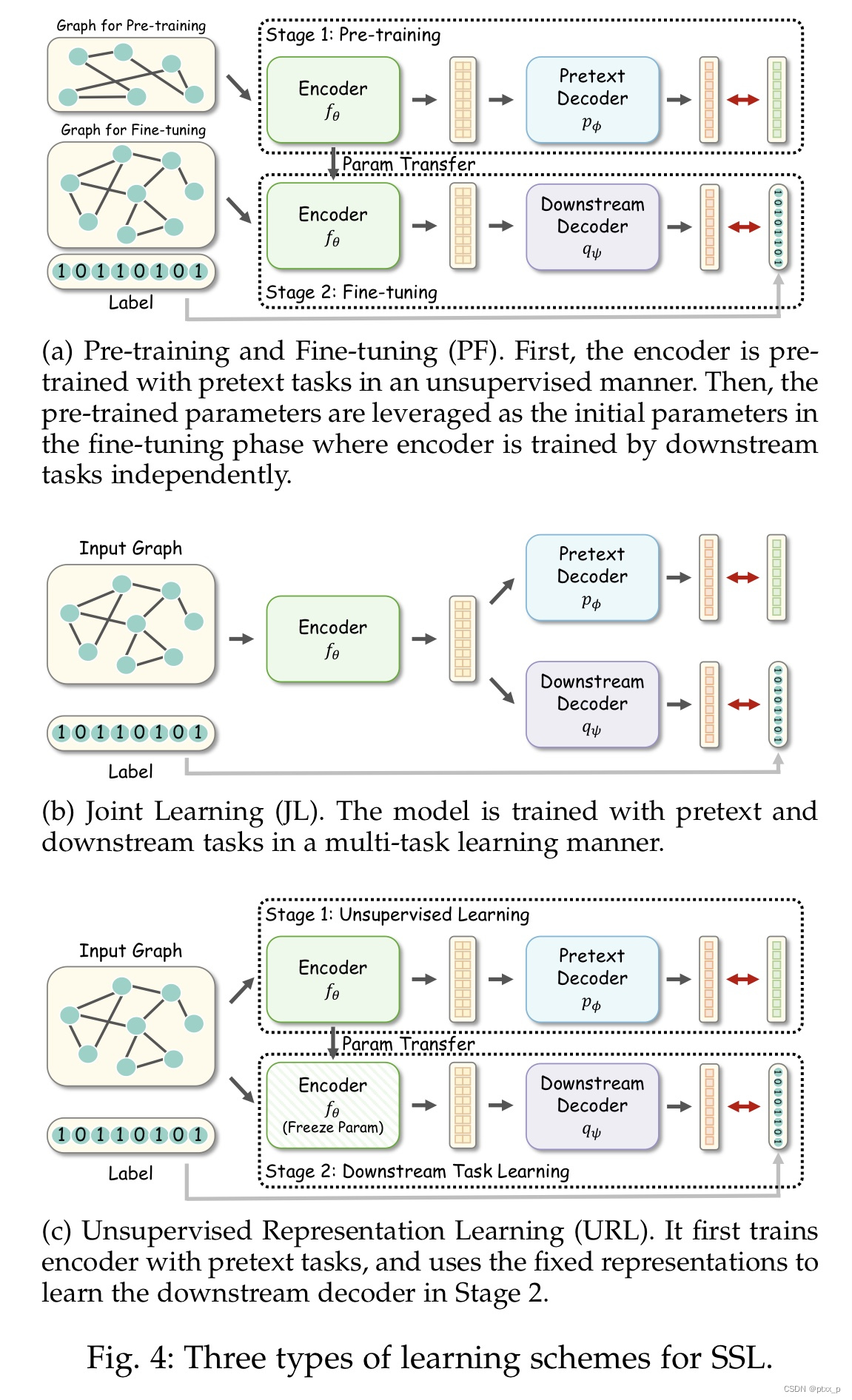
pre-training and fine-tuning(PF):
- encoder f θ f_\theta fθ?首先在pre- training数据集上通过pretext tasks进行pre-train,这可以被视为是对encoder参数的初始化。
- the pre-trained encoder f θ i n i t f_{\theta_{init}} fθinit??在fine-tuning数据集上with a downstream decoder q ψ q_{\psi} qψ? under supervision of specific downstraem tasks进行fine-tune。
θ
?
,
?
?
=
argmin
?
θ
,
?
L
s
s
l
(
f
θ
,
p
?
,
D
)
\theta^*,\phi^* = \operatorname{argmin}_{\theta,\phi}\mathcal{L}_{ssl}(f_\theta,p_\phi,\mathcal{D})
θ?,??=argminθ,??Lssl?(fθ?,p??,D).
θ
?
?
,
?
?
=
argmin
?
θ
?
,
ψ
L
s
u
p
(
f
θ
,
q
ψ
,
G
,
y
)
\theta^{**},\phi^* = \operatorname{argmin}_{\theta^*,\psi}\mathcal{L}_{sup}(f_\theta,q_\psi,\mathcal{G},y)
θ??,??=argminθ?,ψ?Lsup?(fθ?,qψ?,G,y)
pre-training和fine-tuning的数据集可以是一致的或者不一致的。
joint learning(JL):
α
\alpha
α为一个trade-off超参数,JL可以被视为是一种multi-task learning,pretext task可以被视为是一种对downstraem task的regularization:
θ
?
,
?
?
,
ψ
?
=
argmin
?
θ
,
?
,
ψ
[
α
L
s
s
l
(
f
θ
,
p
?
,
D
)
+
L
s
u
p
(
f
θ
,
q
ψ
,
G
,
y
)
]
.
\theta^*,\phi^*,\psi^* = \operatorname{argmin}_{\theta,\phi,\psi}[\alpha \mathcal{L}_{ssl}(f_\theta,p_\phi,\mathcal{D}) +\mathcal{L}_{sup}(f_\theta,q_\psi,\mathcal{G},y)].
θ?,??,ψ?=argminθ,?,ψ?[αLssl?(fθ?,p??,D)+Lsup?(fθ?,qψ?,G,y)].
unsupervised representation learning(URL):
URL 策略的第一步几乎和PF是一样的。两者的不同在于:
- 第二步的encoder的参数frozen了(在下游任务的训练过程中)。
- 这两步的训练使用相同的数据集。
θ
?
,
?
?
=
argmin
?
θ
,
?
L
s
s
l
(
f
θ
,
p
?
,
D
)
\theta^*,\phi^* = \operatorname{argmin}_{\theta,\phi}\mathcal{L}_{ssl}(f_\theta,p_\phi,\mathcal{D})
θ?,??=argminθ,??Lssl?(fθ?,p??,D).
?
?
=
argmin
?
ψ
L
s
u
p
(
f
θ
?
,
q
ψ
,
G
,
y
)
\phi^* = \operatorname{argmin}_{\psi}\mathcal{L}_{sup}(f_\theta^*,q_\psi,\mathcal{G},y)
??=argminψ?Lsup?(fθ??,qψ?,G,y)
和其他策略相比,URL更加具有挑战性,因为在encoder的训练过程中无监督信息(因为encoder参数被冻结了)。
3.4 下游任务的分类
下游任务可以被大致分为:node-、link-、graph-level tasks。
四、generation-based methods
可以大致被分为:feature generation、structure generation。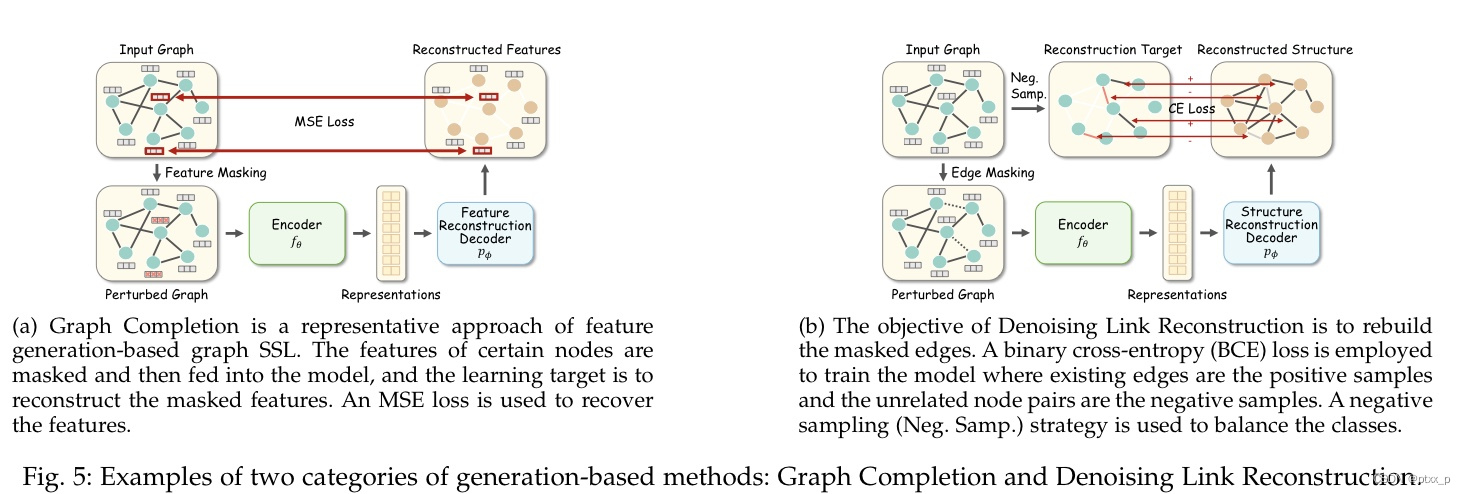

4.1 feature generation
feature generation:learn by recovering feature information from the perturbed or original graphs。
θ
?
,
?
?
=
argmin
?
θ
,
?
L
m
s
e
(
p
?
(
f
θ
(
G
~
)
)
,
X
^
)
.
\theta^*,\phi^* = \operatorname{argmin}_{\theta,\phi}\mathcal{L}_{mse}(p_{\phi}(f_{\theta}(\tilde{\mathcal{G}})),\hat{X}).
θ?,??=argminθ,??Lmse?(p??(fθ?(G~?)),X^).
其中,
p
?
(
?
)
p_\phi(\cdot)
p??(?)is the decoder for feature regression(如:一个全连接网络用于maps: representations -> reconstructed features)
X
^
\hat{X}
X^是各种feature matrices的通用表示。
为了利用节点之间的依赖性,一种具有代表性的特征生成的branch follows the masked feature regression strategy.
举例:graph completion:
X
^
=
X
,
G
~
=
(
A
,
X
~
)
\hat{X} = X,\tilde{\mathcal{G}}=(A,\tilde{X})
X^=X,G~?=(A,X~).
attibutedMask:
X
^
=
P
C
A
(
X
)
\hat{X} = PCA(X)
X^=PCA(X),因此还原高维稀疏的raw data是很困难的.
attrMasking:
X
^
=
[
X
,
X
e
d
g
e
]
\hat{X} = [X,X_{edge}]
X^=[X,Xedge?].
另一种代表性的branch是利用noisy features。 G ~ = ( A , X ~ ) \tilde{\mathcal{G}}=(A,\tilde{X}) G~?=(A,X~),其中 X ~ \tilde{X} X~ is corrupted with random noise。
还可以直接使用clean data 来 rebuilding features. G ~ = ( A , X ) . \tilde{\mathcal{G}}=(A,X). G~?=(A,X).
4.2 structure generation
learn by recovering the structural information。在多数情况下,都是重构邻接矩阵。
θ
?
,
?
?
=
argmin
?
θ
,
?
L
s
s
l
(
p
?
(
f
θ
(
G
~
)
)
,
A
)
.
\theta^*,\phi^* = \operatorname{argmin}_{\theta,\phi}\mathcal{L}_{ssl}(p_{\phi}(f_{\theta}(\tilde{\mathcal{G}})),A).
θ?,??=argminθ,??Lssl?(p??(fθ?(G~?)),A).
p
?
(
?
)
p_\phi(\cdot)
p??(?) is a decoder for结构重建,
A
A
A为部分或者全部的邻接矩阵。
邻接矩阵中存在的边一般为positive sample,不存在的为negative。为了避免稀疏邻接矩阵的unbalanced问题:1.re-weighting A i , j = 1 A_{i,j}=1 Ai,j?=1的系数。 2.sub- sampling terms with A i , j = 0 A_{i,j}=0 Ai,j?=0.
两大类:rebuilding the full graph / reconstruct the masked edges。
讨论:
structure generation:更多利用node pair-level information。
feature generation:更多利用node level knowledge。
五、auxiliary property-based methods
auxiliary property-based methods从node-、link-、graph- level properties来获得监督信息。和监督学习是几乎一样的训练模式:learn with sample-label pairs。但是监督学习里的标签是手工标签,而auxiliary property-based methods是伪标签:self-generated automatically without any cost。大致可以分为两类:auxiliary property classification、auxiliary property regression。
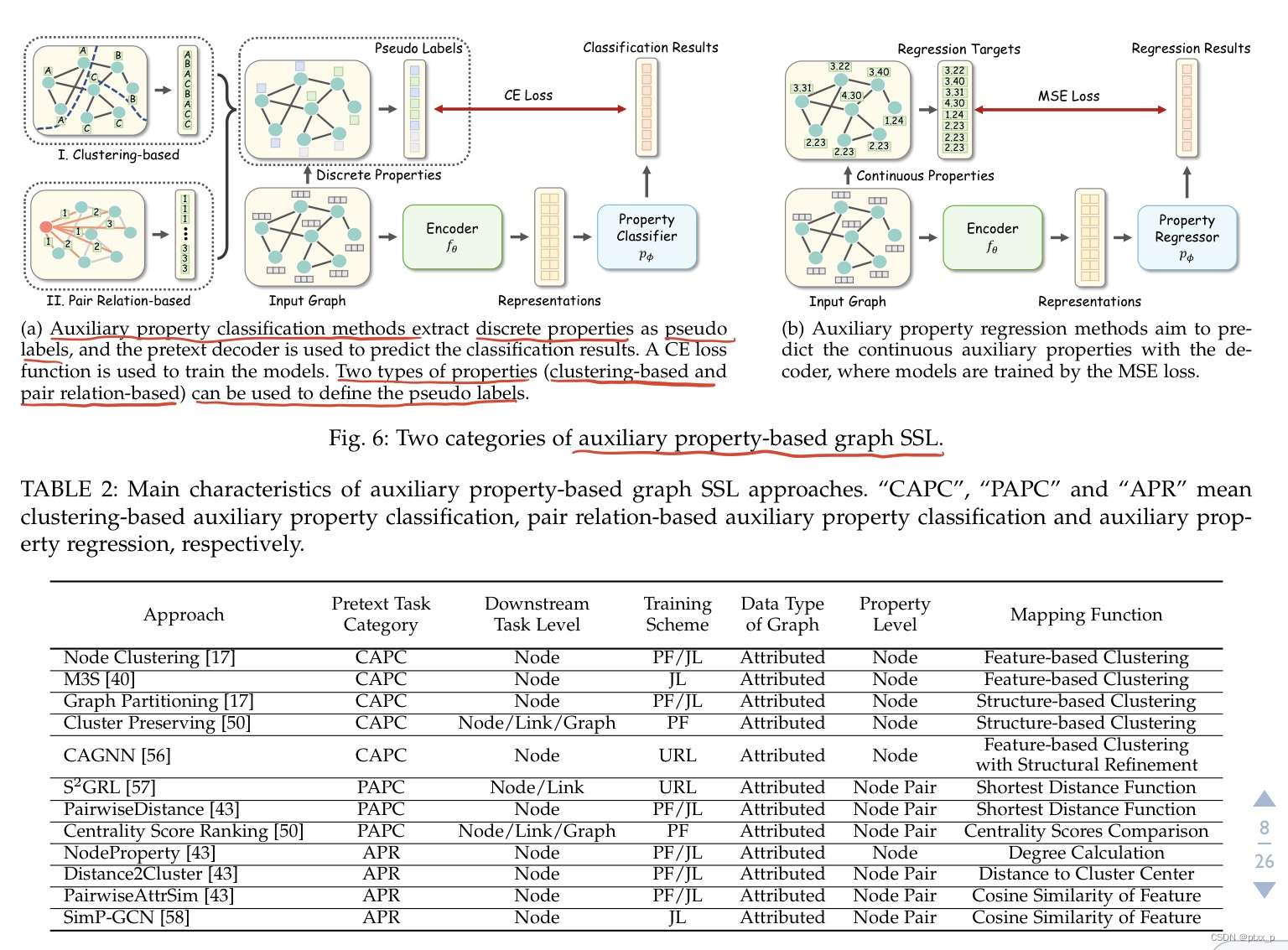
5.1 auxiliary property classification
θ
?
,
?
?
=
argmin
?
θ
,
?
L
s
s
l
(
p
?
(
f
θ
(
G
)
)
,
c
)
.
\theta^*,\phi^* = \operatorname{argmin}_{\theta,\phi}\mathcal{L}_{ssl}(p_{\phi}(f_{\theta}({\mathcal{G}})),\mathcal{c}).
θ?,??=argminθ,??Lssl?(p??(fθ?(G)),c).
其中
p
?
p_{\phi}
p?? 是基于神经网络分类器的decoder,输出是一个k维的概率向量(k为类别的数目),
c
c
c是相关的伪标签(属于伪标签集合
C
C
C)。根据伪标签集合
C
C
C的不同,大致可以分为两类:clustering-based、pair relation-based method。
5.1.1 clustering-based methods
a promising way to construct 伪标签:根据节点特征和结构属性将节点划分为不同的clusters。
mapping function :
Ω
:
V
→
C
\Omega : V \to C
Ω:V→C,用于为每个节点获得伪标签,一般基于无标签聚类或者是切分算法。
learning objective:
θ
?
,
?
?
=
argmin
?
θ
,
?
1
∣
V
∣
∑
v
i
∈
V
L
c
e
(
p
?
(
[
f
θ
(
G
)
]
v
i
)
,
Ω
(
v
i
)
)
.
\theta^*,\phi^* = \operatorname{argmin}_{\theta,\phi} \frac{1}{|V|}\sum_{v_i \in V}\mathcal{L}_{ce}(p_{\phi}([f_{\theta}({\mathcal{G}})]_{v_i}),\Omega(v_i)).
θ?,??=argminθ,??∣V∣1?vi?∈V∑?Lce?(p??([fθ?(G)]vi??),Ω(vi?)).
其中,
[
?
]
v
i
[\cdot]_{v_i}
[?]vi??代表the picking function to extract the representation of
v
i
.
v_i.
vi?.
feature-based clustering:by feature-based clustering algorithm。
structure-based clustering:by minimizing the connections across subsets。
5.1.2 pair relation-based methods
关注于:the relationship between each pair of nodes within a graph。输入是:a pair of nodes。
mapping function :
Ω
:
V
×
V
→
C
\Omega : V \times V \to C
Ω:V×V→C,用于根据pair-wise contextual relationship来获得伪标签。
objective function:
θ
?
,
?
?
=
argmin
?
θ
,
?
1
∣
P
∣
∑
v
i
,
v
j
∈
P
L
c
e
(
p
?
(
[
f
θ
(
G
)
]
v
i
,
v
j
)
,
Ω
(
v
i
,
v
j
)
)
.
\theta^*,\phi^* = \operatorname{argmin}_{\theta,\phi} \frac{1}{|P|}\sum_{v_i ,v_j\in P}\mathcal{L}_{ce}(p_{\phi}([f_{\theta}({\mathcal{G}})]_{v_i,v_j}),\Omega(v_i,v_j)).
θ?,??=argminθ,??∣P∣1?vi?,vj?∈P∑?Lce?(p??([fθ?(G)]vi?,vj??),Ω(vi?,vj?)).
P
?
V
×
V
P \subseteq V\times V
P?V×V:node pair set defined by specific tasks.
[
?
]
v
i
,
v
j
[\cdot]_{v_i,v_j}
[?]vi?,vj??:picking function that extracts and concats the node representations of
v
i
,
v
j
.
v_i,v_j.
vi?,vj?.
5.2 auxiliary property regression
和auxiliary property classification相比,auxiliary properties是一定范围内的连续值(而不是一个有限集合里的离散伪标签)。
θ
?
,
?
?
=
argmin
?
θ
,
?
L
m
s
e
(
p
?
(
f
θ
(
G
)
)
,
c
)
.
\theta^*,\phi^* = \operatorname{argmin}_{\theta,\phi}\mathcal{L}_{mse}(p_{\phi}(f_{\theta}({\mathcal{G}})),\mathcal{c}).
θ?,??=argminθ,??Lmse?(p??(fθ?(G)),c).
c
∈
R
c\in \mathbb{R}
c∈R 是一个连续的属性值。这种属性值可以是节点度、local node importance,local clustering coefficient。
以节点度举例:
θ
?
,
?
?
=
argmin
?
θ
,
?
1
∣
V
∣
∑
v
i
∈
V
L
m
s
e
(
p
?
(
[
f
θ
(
G
)
]
v
i
)
,
Ω
(
v
i
)
)
.
\theta^*,\phi^* = \operatorname{argmin}_{\theta,\phi}\frac{1}{|V|}\sum_{v_i \in V}\mathcal{L}_{mse}(p_{\phi}([f_{\theta}({\mathcal{G}})]_{v_i}),\Omega(v_i)).
θ?,??=argminθ,??∣V∣1?vi?∈V∑?Lmse?(p??([fθ?(G)]vi??),Ω(vi?)).
Ω
(
v
i
)
=
∑
j
=
1
n
A
i
j
.
\Omega(v_i) = \sum_{j=1}^{n}A_{ij}.
Ω(vi?)=∑j=1n?Aij?.
也可以利用pair-wise property作为回归目标:
θ
?
,
?
?
=
argmin
?
θ
,
?
1
∣
P
∣
∑
v
i
,
v
j
∈
P
L
m
s
e
(
p
?
(
[
f
θ
(
G
)
]
v
i
,
v
j
)
,
Ω
(
v
i
,
v
j
)
)
.
\theta^*,\phi^* = \operatorname{argmin}_{\theta,\phi}\frac{1}{|P|}\sum_{v_i,v_j \in P}\mathcal{L}_{mse}(p_{\phi}([f_{\theta}({\mathcal{G}})]_{v_i,v_j}),\Omega(v_i,v_j)).
θ?,??=argminθ,??∣P∣1?vi?,vj?∈P∑?Lmse?(p??([fθ?(G)]vi?,vj??),Ω(vi?,vj?)).
举例:
Ω
(
v
i
,
v
j
)
=
c
o
s
i
n
e
(
v
i
,
v
j
)
\Omega(v_i,v_j) = cosine(v_i,v_j)
Ω(vi?,vj?)=cosine(vi?,vj?):the cosine similarity of raw features。
讨论:classification的方法比regression更多,因为有很多的定义离散伪标签的方法。更多连续属性的应用研究can be future direction。
六、contrast-based methods
基于对比的方法基于the idea of 互信息最大化(mutual information maximization),learns by predicting the agreement between two augmented instances。
存在各种各样的图增强和对比学习的pretext tasks。可以分为三个部分来讲解说明这种方法。
1.graph augmentation:用于生成各种各样的graph instances。
2.graph contrastive learning:在非欧几里得空间中生成各种各样的contrastive pretext tasks。
3.mutual information estimation:measures the MI between instances and forms the contrastive learning objective together with specific pretext tasks。
6.1 graph augmentations
现在的图增强方法大致可以被分为:attributive-based、topological-based、hybrid augmentations。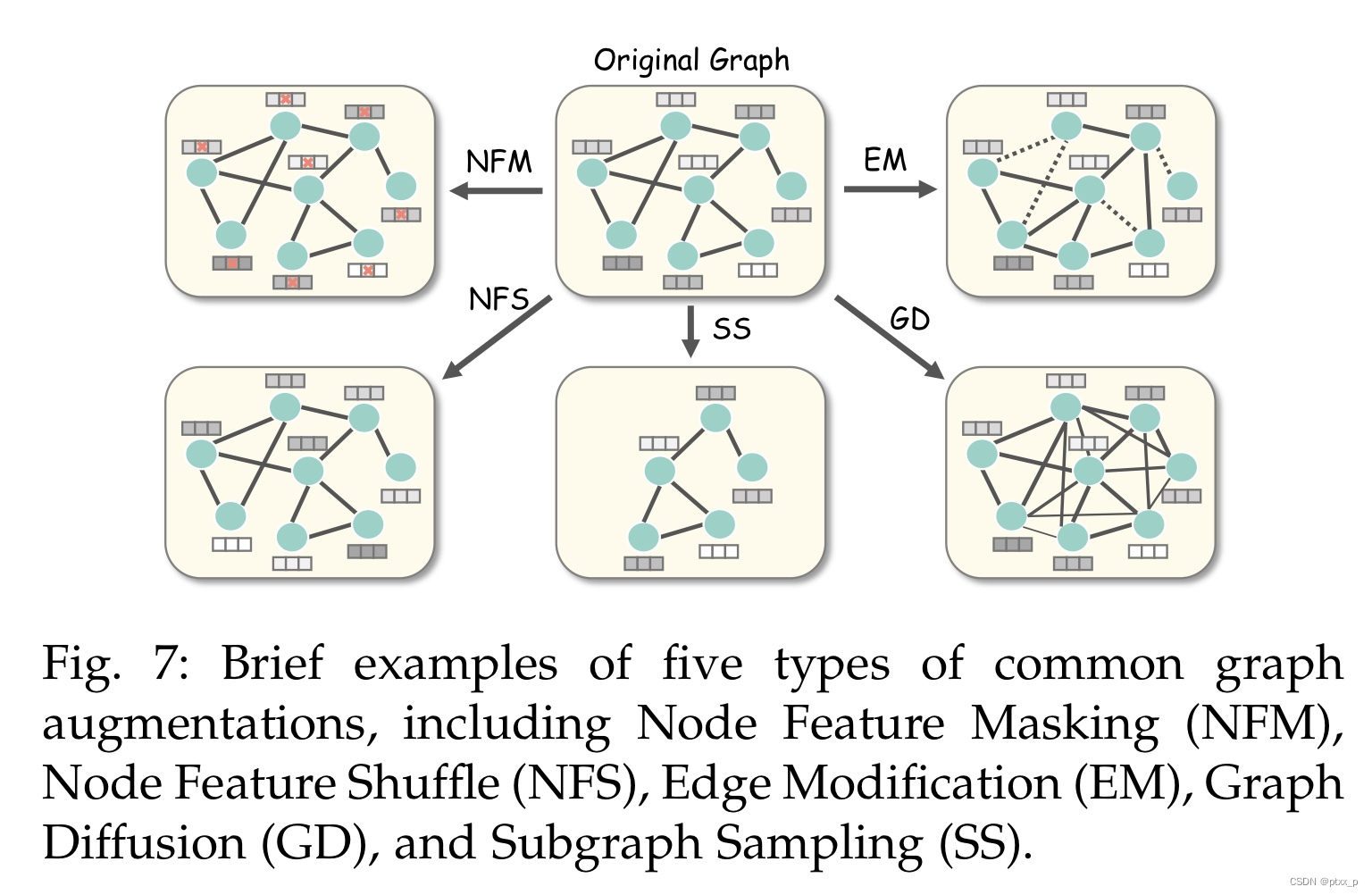
给定图
G
G
G,the i-th augmented graph instance:
G
~
(
i
)
=
t
i
(
G
)
,
t
i
~
τ
\tilde{G}^{(i)} = t_i(G), t_i\sim \tau
G~(i)=ti?(G),ti?~τ is a selected 图增强,
τ
\tau
τ is a set of available augmentations。
6.1.1 attributive augmentations
G
=
(
A
,
X
)
G = (A,X)
G=(A,X), the augmented graph:
G
~
(
i
)
=
(
A
,
X
~
(
i
)
)
=
(
A
,
t
i
(
X
)
)
.
\tilde{G}^{(i)}=(A,\tilde{X}^{(i)}) = (A,t_i(X)).
G~(i)=(A,X~(i))=(A,ti?(X)).
attributive augmentations have 2 variants:node feature masking(NFM),node feature shuffle(NFS)。
node feature masking(NFM): 随机mask掉一部分节点的特征。
t
i
(
X
)
=
M
°
X
t_i(X) = M\circ X
ti?(X)=M°X
M:masking matrix,
°
\circ
°:哈达玛积。
除了M矩阵随机生成外,还可以calculate it adaptively:keep important nodes featires unmasked。
node feature shuffle(NFS): partially and row- wisely perturbs the node feature matrix。
t
i
(
X
)
=
[
X
]
V
~
.
t_i(X) = [X]_{\tilde{V}}.
ti?(X)=[X]V~?.
[
?
]
v
i
[\cdot]_{v_i}
[?]vi??: picking function that indexs the feature vector of
v
i
v_i
vi?.
V
~
\tilde{V}
V~: partially shuffled node set。
6.1.2 topological augmentations
G
~
(
i
)
=
(
A
~
(
i
)
,
X
)
=
(
t
i
(
A
)
,
X
)
.
\tilde{G}^{(i)}=(\tilde{A}^{(i)},X) = (t_i(A),X).
G~(i)=(A~(i),X)=(ti?(A),X).
两种典型方法是:edge modification(EM)、graph diffusion(GD).
edge modification(EM): 通过随机丢弃或者插入边来干扰给定的图邻接矩阵。
t
i
(
A
)
=
M
1
°
A
+
M
2
°
(
1
?
A
)
.
t_i(A) = M_1 \circ A + M_2 \circ (1-A).
ti?(A)=M1?°A+M2?°(1?A).
M
1
,
M
2
M_1,M_2
M1?,M2?分别是edge dropping 和 insertion matrix,其实就是随机masking矩阵,它们也可以calculate adaptively。
graph diffusion(GD): 为给定的邻接矩阵添加更加全局的拓扑信息:通过连接不直接连接的邻居。
t
i
(
A
)
=
∑
k
=
0
∞
Θ
k
T
k
.
t_i(A) = \sum_{k=0}^\infty \Theta_k T^k.
ti?(A)=k=0∑∞?Θk?Tk.
Θ
\Theta
Θ: weighting coefficient.
T
T
T: transition matrix.
特别的,具有两种初始化方法:
-
Θ k = e ? ι t k k ! , T = A D ? 1 . \Theta_k = \frac{e^{-\iota}t^k}{k!}, T = AD^{-1}. Θk?=k!e?ιtk?,T=AD?1.
t i ( A ) = e x p ( ι A D ? 1 ? ι ) . t_i(A) = \mathop{exp}(\iota AD^{-1}-\iota). ti?(A)=exp(ιAD?1?ι).
ι \iota ι: the diffusion time。 -
the personalized pagerank-based graph diffusion:
Θ k = β ( 1 ? β ) k , T = D ? 1 2 A D ? 1 2 . \Theta_k = \beta(1-\beta)^k, T = D^{-\frac{1}{2}}AD^{-\frac{1}{2}}. Θk?=β(1?β)k,T=D?21?AD?21?.
t i ( A ) = β ( I ? ( 1 ? β ) ) D ? 1 2 A D ? 1 2 . t_i(A) = \beta(I-(1-\beta)) D^{-\frac{1}{2}}AD^{-\frac{1}{2}}. ti?(A)=β(I?(1?β))D?21?AD?21?.
β \beta β: the tunable teleport probability.
6.1.3 hybrid augmentations
G
~
(
i
)
=
(
A
~
(
i
)
,
X
~
(
i
)
)
=
(
t
i
(
A
,
X
)
)
.
\tilde{G}^{(i)}=(\tilde{A}^{(i)},\tilde{X}^{(i)}) = (t_i(A,X)).
G~(i)=(A~(i),X~(i))=(ti?(A,X)).
一种典型的hybrid graph augmentation:subgraph sampling(SS).
t
i
(
A
,
X
)
=
[
(
A
,
X
)
]
V
′
∈
V
.
t_i(A,X) = [(A,X)]_{V' \in V}.
ti?(A,X)=[(A,X)]V′∈V?.
V
′
V'
V′是
V
V
V的子集,可以使用多种的子集生成方法。
hybrid augmentations也可以是组合前面提到的多种图增强方法。
6.2 graph contrastive learning
可以大致分为:same-scale 、cross-scale contrastive learning。

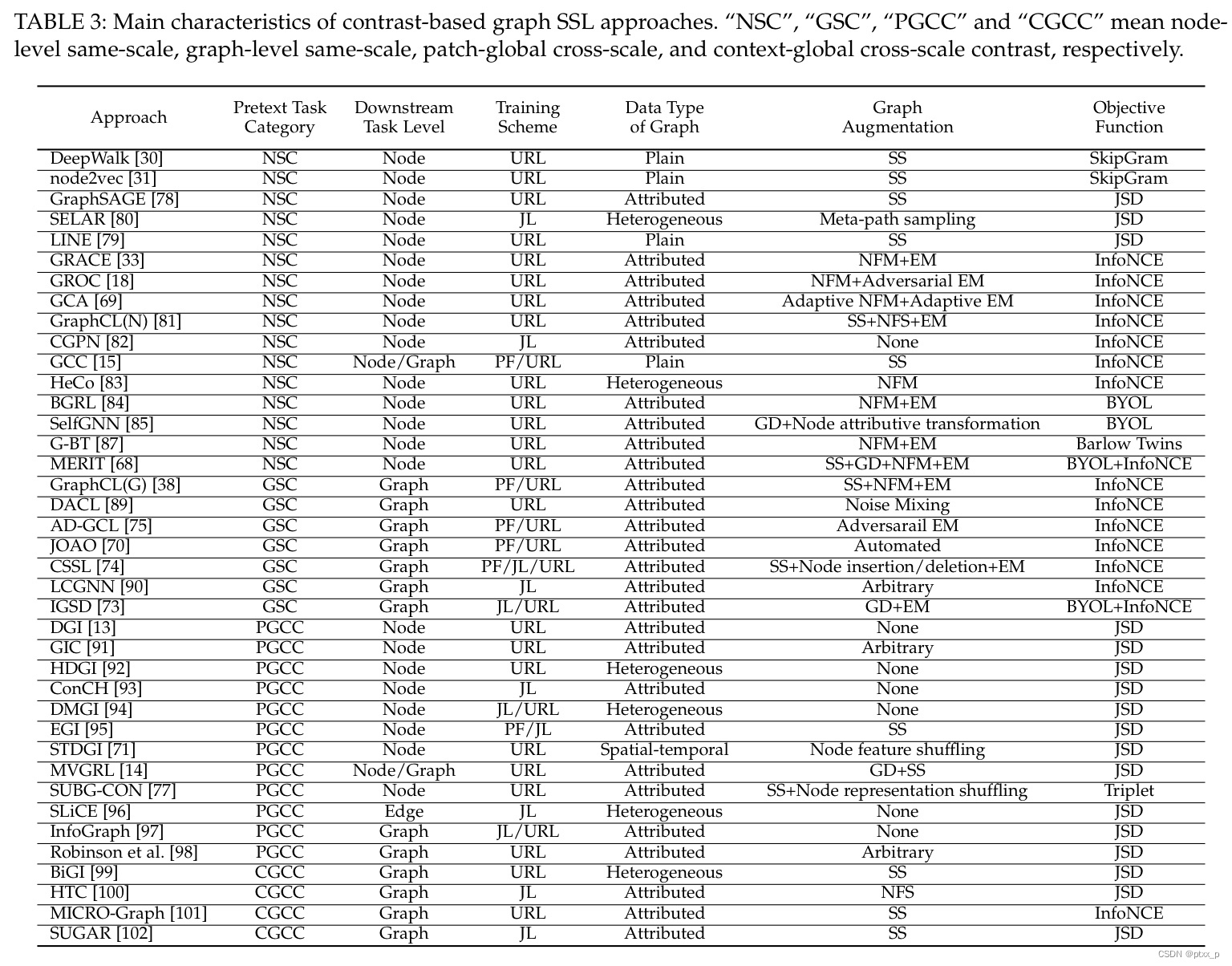
6.2.1 same-scale contrast
可以进一步被分为:node-level和graph-level。
6.2.1.1 node-level same-scale contrast
θ
?
=
a
r
g
m
i
n
θ
1
∣
V
∣
∑
v
i
∈
V
L
c
o
n
(
p
(
[
f
θ
(
A
,
X
)
]
v
i
,
[
f
θ
(
A
,
X
)
]
v
c
)
)
.
\theta^* = argmin_{\theta}\frac{1}{|V|}\sum_{v_i \in V}L_{con}(p([f_\theta(A,X)]_{v_i},[f_\theta(A,X)]_{v_c})).
θ?=argminθ?∣V∣1?vi?∈V∑?Lcon?(p([fθ?(A,X)]vi??,[fθ?(A,X)]vc??)).
v
c
v_c
vc?: the contextual node of
v
i
v_i
vi?, e.g. a neighboring node in a random walk starting from
v
i
v_i
vi?.
这里的
p
p
p一般是点乘。
modern node-level same-scale contrastive methods:under various graph augmentations, instead limiting on subgraph sampling.
θ
?
,
?
?
=
a
r
g
m
i
n
θ
,
?
L
c
o
n
(
p
?
(
f
θ
(
A
~
(
1
)
,
X
~
(
1
)
)
,
f
θ
(
A
~
(
2
)
,
X
~
(
2
)
)
)
)
.
\theta^*,\phi^* = argmin_{\theta,\phi}L_{con}(p_\phi(f_\theta(\tilde{A}^{(1)},\tilde{X}^{(1)}),f_\theta(\tilde{A}^{(2)},\tilde{X}^{(2)}))).
θ?,??=argminθ,??Lcon?(p??(fθ?(A~(1),X~(1)),fθ?(A~(2),X~(2)))).
拉近相似节点、推远不相关节点(构造负样本)。
6.2.1.2 graph-level same-scale contrast
θ
?
,
?
?
=
a
r
g
m
i
n
θ
,
?
L
c
o
n
(
p
?
(
g
~
(
1
)
,
g
~
(
2
)
)
)
.
\theta^*,\phi^* = argmin_{\theta,\phi}L_{con}(p_\phi(\tilde{g}^{(1)},\tilde{g}^{(2)})).
θ?,??=argminθ,??Lcon?(p??(g~?(1),g~?(2))).
g
~
(
i
)
=
R
(
f
θ
(
A
~
(
i
)
,
X
~
(
i
)
)
)
\tilde{g}^{(i)} = R(f_\theta(\tilde{A}^{(i)},\tilde{X}^{(i)}))
g~?(i)=R(fθ?(A~(i),X~(i))), R is the readout function.
6.2.2 cross-scale contrast
可以大致被分为:patch-global and context- global contrast。
6.2.2.1 patch-global cross-scale contrast
θ
?
,
?
?
=
a
r
g
m
i
n
θ
,
?
1
∣
V
∣
∑
v
i
∈
V
L
c
o
n
(
p
?
(
[
f
θ
(
A
,
X
)
]
v
i
,
R
(
f
θ
(
A
,
X
)
)
)
)
.
\theta^*,\phi^* = argmin_{\theta,\phi}\frac{1}{|V|}\sum_{v_i \in V}L_{con}(p_\phi([f_\theta(A,X)]_{v_i},R(f_\theta(A,X)))).
θ?,??=argminθ,??∣V∣1?vi?∈V∑?Lcon?(p??([fθ?(A,X)]vi??,R(fθ?(A,X)))).
node-level representation <-> graph-level representation:最大化它们之间的互信息,来帮助graph encoder to learn both localized and global semantic information。
上面提到的方法没有显式地使用图增强,使用图增强:
θ
?
,
?
?
=
a
r
g
m
i
n
θ
,
?
1
∣
V
∣
∑
v
i
∈
V
L
c
o
n
(
p
?
(
h
~
i
(
1
)
,
g
~
(
2
)
)
)
.
\theta^*,\phi^* = argmin_{\theta,\phi}\frac{1}{|V|}\sum_{v_i \in V}L_{con}(p_\phi(\tilde{h}_i^{(1)},\tilde{g}^{(2)})).
θ?,??=argminθ,??∣V∣1?vi?∈V∑?Lcon?(p??(h~i(1)?,g~?(2))).
h
~
i
(
1
)
=
[
f
θ
(
A
~
(
1
)
,
X
~
(
1
)
)
]
v
i
\tilde{h}_i^{(1)}=[f_\theta(\tilde{A}^{(1)},\tilde{X}^{(1)})]_{v_i}
h~i(1)?=[fθ?(A~(1),X~(1))]vi??:representation of node
v
i
v_i
vi? in augmentation view1.
g
~
(
2
)
=
R
(
f
θ
(
A
~
(
2
)
,
X
~
(
2
)
)
)
\tilde{g}^{(2)}=R(f_\theta(\tilde{A}^{(2)},\tilde{X}^{(2)}))
g~?(2)=R(fθ?(A~(2),X~(2))):representation of augmentation view2.
6.2.2.2 context-global cross-scale contrast
context:上下文。
θ
?
,
?
?
=
a
r
g
m
i
n
θ
,
?
1
∣
S
∣
∑
s
∈
S
L
c
o
n
(
p
?
(
h
~
s
,
g
~
)
)
.
\theta^*,\phi^* = argmin_{\theta,\phi}\frac{1}{|S|}\sum_{s\in S}L_{con}(p_\phi(\tilde{h}_s,\tilde{g})).
θ?,??=argminθ,??∣S∣1?s∈S∑?Lcon?(p??(h~s?,g~?)).
S
S
S: 增强的输入图
G
~
\tilde{G}
G~的上下文子图集合(contextual subgraphs),这里的图增强一般是图采样。
h
~
s
\tilde{h}_s
h~s?: the representation of augmented contextual subgraph s.
g
~
\tilde{g}
g~?: the graph-level representation over all subgraphs in S.
h ~ s = R ( [ f θ ( A ~ , X ~ ) ] v i ∈ s ) , g ~ = R ( f θ ( A ~ , X ~ ) ) . \tilde{h}_s = R([f_\theta(\tilde{A},\tilde{X})]_{v_i \in s}),\tilde{g} = R(f_\theta(\tilde{A},\tilde{X})). h~s?=R([fθ?(A~,X~)]vi?∈s?),g~?=R(fθ?(A~,X~)).
6.3 mutual information estimation
给定a pair of instance
(
x
i
,
x
j
)
(x_i,x_j)
(xi?,xj?), let
(
h
i
,
h
j
)
(h_i,h_j)
(hi?,hj?) denote their representations. the MI between
(
i
,
j
)
(i,j)
(i,j):

2 common forms of lower bound:Jensen-Shannon Estimator、Noise-Contrastive Estimator.
6.3.1 Jensen-Shannon Estimator
Jensen-Shannon (JSD): 提供了MI的有效估计和紧下界。基于JSD的对比损失定义如下:

h
i
,
h
j
~
P
,
h
~
j
′
~
P
~
h_i,h_j \sim P, \tilde{h}_j'\sim \tilde{P}
hi?,hj?~P,h~j′?~P~。
p
?
(
?
)
p_\phi(\cdot)
p??(?)可以是多种形式:如bilinear transformation.
p
?
(
h
i
,
h
j
)
=
h
i
T
Φ
h
j
p_\phi(h_i,h_j) = h_i^T \Phi h_j
p??(hi?,hj?)=hiT?Φhj?…
6.3.2 Noise-Contrastive Estimator
Noise-Contrastive Estimator也提供了a lower bound MI estimation,自然地关联了a positive and N negative pairs:

6.3.3 triplet loss
注意:minimizing this loss can not guarantee that the MI is being maximized because it cannot represent the lower bound of MI:

6.3.4 BYOL loss
not relying on negative samples:

6.3.5 Barlow Twins Loss

the representation of 2 views:
H
(
1
)
,
H
(
2
)
H^{(1)},H^{(2)}
H(1),H(2) for a batch of data instances sampled from a distribution
P
P
P.
